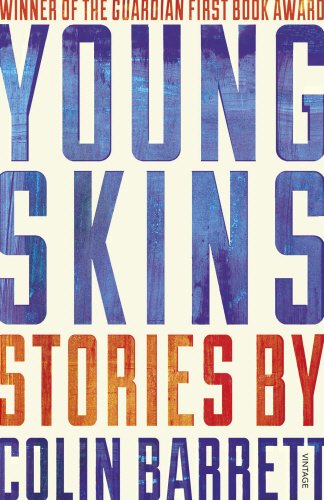
photo © Marcella Bona, 2010
by David Butler
In an interview conducted for The Paris Review, published in March this year, short story writer Colin Barrett suggested:
If you grow up in a small town and every weekend go to shoot pool and sink beers and encounter the same fifty faces over the course of the night, then every weekend becomes a rehearsal for the next. It’s like an ad hoc play you are performing in over and over again, so you develop a script. And the sheer routineness of community life engenders creativity. You have to come up with new ways of saying the same old thing, of standing the same old ring of faces.
The ad hoc scripts he develops in the six stories and the novella that make up his award-winning debut collection, Young Skins, are all set within the confines and deadening routines of the fictional rural community of Glanbeigh, located not far from the Atlantic’s ‘gnarled jawbone’.
‘My town is nowhere you’ve been, but you know its ilk’, the collection begins. And we do know it, intimately. It’s the ecosystem of Billy Roche’s Wexford Trilogy, of Tom Murphy’s representation of Tuam, and Kevin Barry’s of County Sligo, all with their predominantly male malcontents enacting dramas of repetition and entrapment in the bars and dance halls and poolrooms of small town Ireland. It is, too, the boozy, boastful habitat of many of James Joyce’s stories, and some key episodes of Ulysses, set though they are within the limiting frame of the provincial backwater of colonial Dublin. John MacGahern, Brian Friel, Donal Ryan, Conor McPherson and William Trevor have all explored this place. People stay, people go and return. Loners collide in their solitude like cue balls, take rough solace in sex or casual violence, in drink and braggadocio. It is the deadening rural community where nothing changes, except perhaps that the church’s dead hand has become less prominent.
 How, then, does Barrett ‘come up with new ways of saying the same old thing’? In the same Paris Review interview, he explains that, rather than character or plot, the first impulse to write a story, and the focus of interest, remains squarely on language. In a revealing image, he explains: ‘What I look for in sentences is a gnarl, a knuckliness. It’s textural, like a striae or a burr, some embedded trace within the sentence where the register changes or shifts.’ He talks about ‘doing the right kind of damage’ to the cadence of a sentence.
How, then, does Barrett ‘come up with new ways of saying the same old thing’? In the same Paris Review interview, he explains that, rather than character or plot, the first impulse to write a story, and the focus of interest, remains squarely on language. In a revealing image, he explains: ‘What I look for in sentences is a gnarl, a knuckliness. It’s textural, like a striae or a burr, some embedded trace within the sentence where the register changes or shifts.’ He talks about ‘doing the right kind of damage’ to the cadence of a sentence.
Certainly, the vigour and the unexpected accuracies of much of his imagery is apparent, and impressive. In ‘Diamonds’, an alcoholic’s mutilated hand is described in terms of ‘the abrupt drumlins of his knuckles’ – and, elsewhere, a girl’s drink contains ‘knuckles of ice’ – while a Turkish takeaway displays ‘the flayed loaves of chicken and pork revolving on their spits in the window’. His story ‘Bait’ describes the faces of the ‘irrelevantly elderly’, who are lining a bar, as ‘drink-cudgelled’, while a character assembling a cue ‘worked the joint to a seamless squeak’. The same story closes, in a masochistic fantasy, with bottle-scratches across a face being irritated by ‘the precise fire of vodka’. And a striking comparison from the closing story, ‘Kindly Forget my Existence’, explains that pouring a pint from the wrong side of a bar ‘required the same queasy narrowness of concentration as writing with your weaker hand’. The most perfectly achieved story, ‘Stand Your Skin’, opens with a daddy-long-legs trapped within a sink basin, as it ‘pedals airily’ in a ‘flustered circle’. Besides their descriptive liveliness, Barret’s verbal couplings such as ‘abrupt drumlins’, ‘seamless squeak’, and ‘queasy narrowness’, display his remarkable ear for acoustic accuracy, their onomatopoeia a source of aural pleasure comparable to that of poetry.
Much of Barrett’s knottiness derives from the unexpected noun or verb. The introverted protagonist of ‘Stand Your Skin’, Bat, attempts to eat whilst painfully aware of a pair of youngsters ‘eyeing the bulky hydraulics of his jaw’, while his hair is described as ‘an inextricable nest of flubs, snarls and knots’. In ‘Bait’, Nubbin Tansey, the town tough, ‘manifested on the premises’, and in ‘The Moon’, the bouncer, Val, ‘was unspooling’ an anecdote to impress a girl. Again, a comparison to poetry springs to mind, in particular to that vigorous poetry which prefers the muscularity of metaphor to simile.
 As one might expect, the novella length ‘Calm With Horses’ abounds in such lexical vigour. Having dispatched a corpse into a river, a killer considers ‘the wilted totem of clothing piled by the water’s edge’; a horse thief ‘felt the heat fluming from the vents of its nostrils’, while stubble on a head is ‘shaved so tight it shone like vapour in the morning light’. When Barrett does opt for a simile, it is well-judged, here suggesting the ethereality of the image. ‘The Clancy Kid’, which opens the collection, provides a car that is overturned to reveal ‘the vasculature of blackened pipes’, while a more recent story, ‘The Ways’, published in The New Yorker in January 2015, posits a garden of snow with ‘dark, snub-bodied birds dabbing across it’ and a jalopy ‘parping cloudlets of straw and dung out the exhaust’.
As one might expect, the novella length ‘Calm With Horses’ abounds in such lexical vigour. Having dispatched a corpse into a river, a killer considers ‘the wilted totem of clothing piled by the water’s edge’; a horse thief ‘felt the heat fluming from the vents of its nostrils’, while stubble on a head is ‘shaved so tight it shone like vapour in the morning light’. When Barrett does opt for a simile, it is well-judged, here suggesting the ethereality of the image. ‘The Clancy Kid’, which opens the collection, provides a car that is overturned to reveal ‘the vasculature of blackened pipes’, while a more recent story, ‘The Ways’, published in The New Yorker in January 2015, posits a garden of snow with ‘dark, snub-bodied birds dabbing across it’ and a jalopy ‘parping cloudlets of straw and dung out the exhaust’.
Is this mere virtuosity the lexical invigoration that one rightly expects to encounter in poetry? If it is, it is also something of a manifesto for Barrett. In the Paris Review article referred to above, he decries:
The kind of writing […] I call lethally competent. Language that takes no chances, that seeks to efface itself as language as a material, and offer the clear windowpane on reality, et cetera. The kind of prose a review might call pellucid, or limpid.
Interestingly, such a manifesto would be diametrically opposed to the transparent language espoused by John McGahern in the widely viewed RTE documentary ‘A Private World’, from 2005, because, in particular, the Cootehall he so meticulously recreates is, although separated by a half-century, imaginatively contiguous to Barrett’s Glanbeigh. For McGahern, language that draws inordinate attention to itself detracts from the story, which must itself remain paramount.
Once again, the ghost of Joyce is invoked. Modernism is a notoriously contentious term, but if the Modernist moment means anything, it is surely the shift away from the subject of enquiry or creation onto the means and medium of representation, creation, or interrogation. This, at least, is a common denominator operating in the century old shift in art from realism to fauvism, synthetic cubism and collage; in the shift from tonal to atonal music based on the chromatic scale; in the linguistic and phenomenological turns in philosophy; in the interrogation of such absolutes as space, time and causation in physics; in the semantic montages of Mallarmé, Apollinaire, the later Joyce and T.S. Eliot. Rather than an emphasis on the subject as viewed through the windowpane, there is, as it were, a change of focal length onto the glass itself, its warps, tints and refractive indices. Etymologically, text and textile are cousins.
Is that what Barrett’s knottiness is about? It is surely too early to tell. Who, encountering the ‘scrupulous meanness’ of Joyce’s Dubliners or, the ‘lethally competent’ ditties of Chamber Music, could possibly have foreseen the semantic pyrotechnics of Ulysses?
~
 A former lecturer in English and Spanish literature, David Butler works as a full time writer. His most recent novel, City of Dis (New Island), was shortlisted for the Kerry Group Irish Novel of the Year, 2015. Other literary prizes include the Maria Edgeworth and Fish International awards for the short story, the SCDA and Cork Arts Theatre awards for drama, and the Feile Filiochta and Brendan Kennelly awards for poetry.
A former lecturer in English and Spanish literature, David Butler works as a full time writer. His most recent novel, City of Dis (New Island), was shortlisted for the Kerry Group Irish Novel of the Year, 2015. Other literary prizes include the Maria Edgeworth and Fish International awards for the short story, the SCDA and Cork Arts Theatre awards for drama, and the Feile Filiochta and Brendan Kennelly awards for poetry.
~
To find out more about Colin Barrett’s writing processes,
listen to his Short Story Masterclass podcast,
recorded for Thresholds last year.

